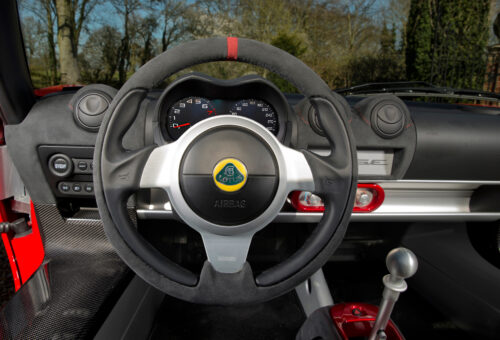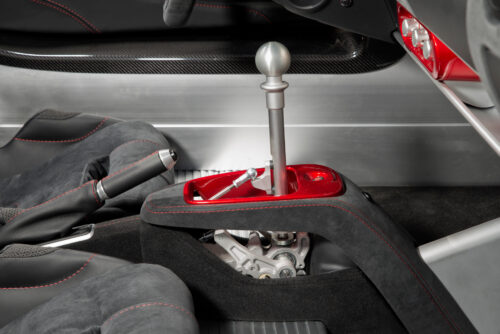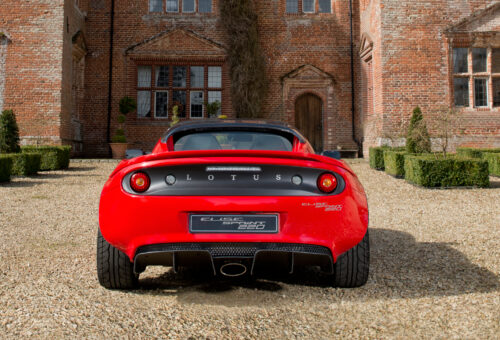Someday the engineers at Lotus will finally do what the company has been trying to do since 1952. They’ll finally design a sports car that weighs nothing at all. On that joyous day engineers will rejoice, auto journalists will salivate, track day enjoyment will hit an all-time high, and Colin Chapman will return with an ecstatic “I KNEW it could be done!”
That magical day hasn’t happened yet, but what has happened is that the gram-obsessed engineers at Lotus have slashed 41,000 of them off of the Lotus Elise to make the Elise Sprint. The new Elise Sprint tips the scales at a shocking 798 kg dry weight, with the more powerful Sprint 220 coming in at just 845 kg.
So how do you take 41 kg off of a car that’s already one of the lightest around? You start with a lithium-ion battery. The same battery that powers your laptop can start a car. Better yet, it’s 9 kg lighter than a lead-acid unit. The seats are now carbon, cutting another 6 kg. Lighter wheels save 5 kg, and might actually be the most noticeable of all of the weight loss. The rotation of the wheels multiplies the effect of the weight, and that’s why almost nothing ruins handling faster than a heavy wheel.
The front and rear access panels are now carbon-fiber, as is the roll hoop. If you plan on tracking your Elise, make sure that a carbon hoop passes their safety rules. The composite is lighter and stronger, but rule books can take a long time to catch up with technology.
Combine the carbon pieces with a polycarbonate rear window and you have another 6 kg. New two-piece brake rotors are 4 kg lighter, and carbon sill covers save 0.8 kg. But that doesn’t add up to 41. Where’s the rest?
The rest of the lightweight changes are coming to the entire Elise lineup, not just the Sprint. A new front clamshell gets bigger radiator openings. Bigger openings means less bodywork, in this case enough to trim another 8.7 kg. Losing two of the taillights (there are now just two instead of four) takes care of 0.3 kg, and the final 1 kg might be the most beautiful.
Lotus has taken the cover off of the shift linkage. Leaving the gearbox gate open and exposed doesn’t just look amazing, it saves weight. Just don’t spill your drink in the mechanism. Cleaning sugary residue off of it would take all day. If you’re doing the math, I know that’s only 40.8. The rest is smaller things that add up to another 200 g or so.
Lotus hasn’t just trimmed weight, though, the new bodywork improves airflow and downforce. Lotus says it has less drag and is more stable at speed.
The Elise Sprint’s engines aren’t changed; the Sprint has a 1.6L four making 134 hp and 118 lb-ft. The Sprint 220 has 1.8L and a supercharger to make 217 horsepower, 184 lb-ft, and has a power to weight ratio of 257 hp/tonne. The lighter weight trims a few tenths off of the 0-100 km/h time, now down to 4.1 seconds for the Sport 220 and 5.9 for the Sport.
The Sprint 220 has a new exhaust system. Lotus engineers spent quite a bit of time on getting it sounding just right. Enough that they’re making the surprisingly bold claim that it is “the best-sounding 4-cylinder car on the market.” Big words and I can’t wait for the chance to hear it. Hopefully from the driver’s seat.
Cutting weight from a car makes it better. At least as far as handling and performance is concerned. Less to move means more acceleration, less to stop means faster braking. It lets the suspension do its job better, and a car that can be tossed around is more fun than a car that needs to be thrown, kicked, or dragged. Simplify, then add lightness. It’s been the philosophy of Lotus since day one.
If you want the lightest version of the Elise, Lotus’ most popular model ever, get your order in now. Deliveries start next month.












